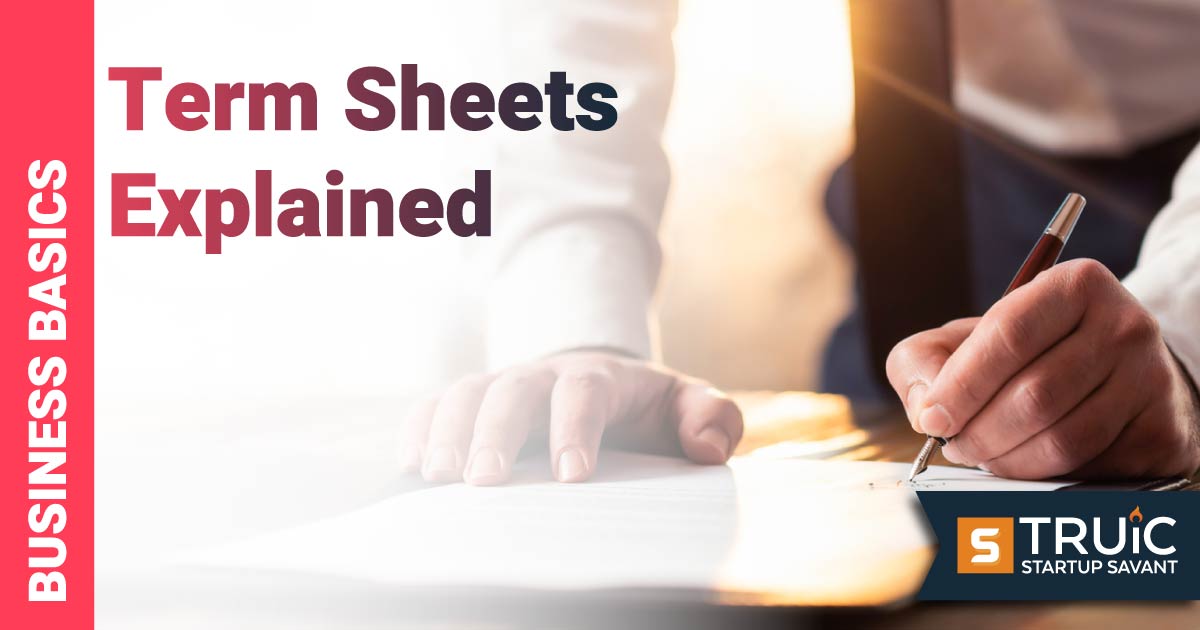Term Sheets Explained

Last Updated: By Michaela Dale
A term sheet serves as a preliminary outline of the major terms and conditions of a business deal, providing a framework for negotiation between parties. Commonly used during fundraising, term sheets streamline the process of reaching an agreement.
While each of these documents is different, we’ve broken down the basics of term sheets to prepare your startup for its next funding round.
What Is a Term Sheet?
A term sheet outlines the basic terms and conditions under which an investment will be made but is not a binding agreement. This is the first formal declaration by the investor of their interest in investing in a startup. A term sheet is similar to a summary or an agreement-in-principle for a business deal, often used in situations like funding a startup or negotiating a partnership.
While the term sheet isn't legally binding, it sets the stage for the more detailed, binding contracts that follow. It's like a handshake in document form, showing that both sides are seriously interested and agree on the main points of the deal.
Uses of Term Sheets
Term sheets communicate relatively broad details of a deal, providing only foundational information relevant to the deal at hand. In-depth information and minor details are not included in the term sheet, they are left for binding contracts that follow.
Terms sheets are most commonly used while raising a new round of funding but can also be used as part of an acquisition or merger. The information included on each term sheet will vary but will generally include pricing and asset information, contingencies, timeframe, and any other information that may be immediately relevant.
What to Include in a Startup Term Sheet
Every term sheet will include different information. However, some key points are included frequently in a term sheet. Most often a term sheet details the company’s valuation, terms for pricing and shares, as well as the rights of the investors involved.
Company Valuation & Investment Amount
This includes pre-money valuation, or the value of the company before investment, and post-money valuation, which is the amount the company will be worth once the new investment is solidified. The amount being raised, or the investment amount, during the relevant funding round should also be included.
Equity Stake
Startup funding is most commonly equity funding raised by venture capitalists and other investors. This means the investors will obtain a percentage of equity in the company in exchange for their investment. This section should include the percentage of the company's equity being offered to the investor in exchange for the investment.
Type of Security Offered
In this section, you should specify the class and form of securities being offered to investors, such as common stock, preferred stock, convertible notes, or warrants. Additionally, this section should detail any unique characteristics or rights associated with these securities, like conversion rights, and dividend preferences, to clearly define what investors are purchasing.
Voting Rights
Voting rights are essentially how much control the investors will have in company decisions, as the lead investor in your round will commonly take a board seat. This will also detail the preferred stockholder veto rights or protective provisions, waiver and amendment provisions (to protect future rounds), right of first refusal or co-sale rights, and drag-along rights.
Liquidation Preference
Liquidation preferences apply to preferred stockholders. This essentially specifies how the proceeds will be distributed among shareholders if the company is acquired, undergoes an initial public offering (IPO), or is liquidated.
Dividend Policy
Dividend policies in a term sheet outline the terms under which a company will distribute profits to its shareholders as dividends. These policies specify the frequency, conditions, and amount of profits that will be paid. This essentially provides clarity for investors about their potential income from dividends.
Anti-Dilution Provisions
Anti-dilution provisions in a term sheet protect investors from a decrease in the value of their shares if the company issues more shares at a lower price in the future such as during a down round. These provisions adjust the price or number of shares the investor holds, ensuring their investment retains its value and preventing their ownership percentage from being diluted in subsequent funding rounds.
Frequently Asked Questions
What is the purpose of a term sheet?
A term sheet serves as a preliminary outline of the major terms and conditions of a business deal, providing a framework for negotiation between parties. It streamlines the process of reaching an agreement by identifying key deal points early on, thus facilitating smoother and more efficient contract drafting and finalization.
What is the difference between a term sheet and an agreement?
A term sheet is a non-binding document that outlines the basic terms and conditions of a business deal, serving primarily as a preliminary agreement for negotiations. In contrast, an agreement is a legally binding contract that finalizes the details of the deal, including obligations, rights, and duties of all parties involved, based on the framework established in the term sheet.
Is a term sheet necessary?
A term sheet is not legally necessary, but it is highly beneficial in many business scenarios, especially in investments and acquisitions. By providing a clear framework for the transaction, term sheets help ensure that both parties are aligned on the major aspects of the deal before moving forward with binding commitments.
What is most important in a term sheet?
The most important aspect of a term sheet varies depending on the specific deal and the parties involved, but generally, the following elements are crucial:
- Company valuation
- Equity stake
- Liquidation Preferences
What is the difference between a term sheet and a stock purchase agreement?
A term sheet simply lays out the details of a business transaction, whereas stock purchase agreements are legally binding documents detailing the amount and type of stock to be purchased, the price, and other key terms.


